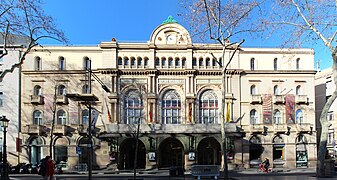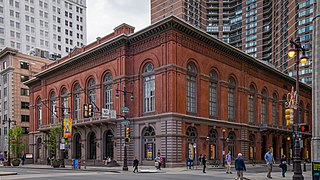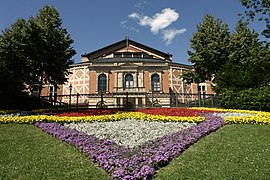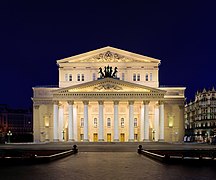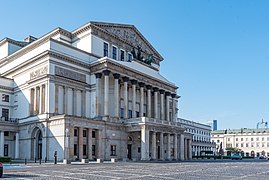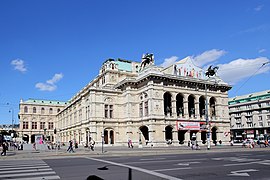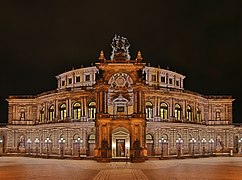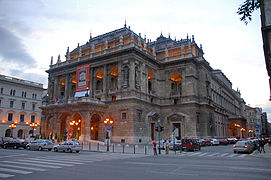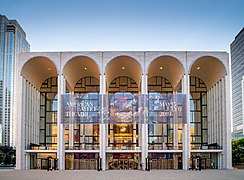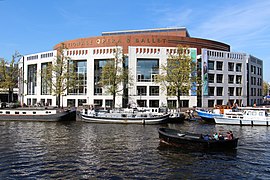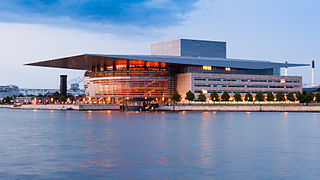
The Teatro Colón is a historic opera house in Buenos Aires, Argentina. It is considered one of the ten best opera houses in the world by National Geographic. According to a survey carried out by the acoustics expert Leo Beranek among leading international opera and orchestra directors, the Teatro Colón has the room with the best acoustics for opera and the second best for concerts in the world.

The Real Teatro di San Carlo, as originally named by the Bourbon monarchy but today known simply as the Teatro (di) San Carlo, is a historic opera house in Naples, Italy, connected to the Royal Palace and adjacent to the Piazza del Plebiscito. It is the oldest continuously active venue for opera in the world, having opened in 1737, decades before either Milan's La Scala or Venice's La Fenice.

The Teatro Comunale di Bologna is an opera house in Bologna, Italy. Typically, it presents eight operas with six performances during its November to April season.

Teatro Regio di Parma, originally constructed as the Nuovo Teatro Ducale, is an opera house and opera company in Parma, Italy.

The Teatro Regio is a prominent opera house and opera company in Turin, Piedmont, Italy. Its season runs from October to June with the presentation of eight or nine operas given from five to twelve performances of each.

The Teatro della Pergola, sometimes known as just La Pergola, is a historic opera house in Florence, Italy. It is located in the centre of the city on the Via della Pergola, from which the theatre takes its name. It was built in 1656 under the patronage of Cardinal Gian Carlo de' Medici to designs by the architect Ferdinando Tacca, son of the sculptor Pietro Tacca; its inaugural production was the opera buffa, Il potestà di Colognole by Jacopo Melani. The opera house, the first to be built with superposed tiers of boxes rather than raked semi-circular seating in the Roman fashion, is considered to be the oldest in Italy, having occupied the same site for more than 350 years.

The Teatro Comunale Alighieri is an opera house located at 2 Via Mariani in Ravenna, Italy and designed by the Venetian architects, Tommaso Meduna and his brother, Giambattista who had designed the second La Fenice theatre after the fire of 1836. The new Teatro Comunale Alighieri was inaugurated on 15 May 1852 with a production of Meyerbeer's Robert le diable, followed by Giovanni Pacini's Medea.
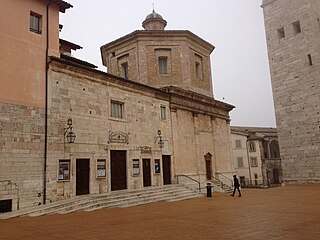
The Teatro Caio Melisso is an opera house located in Spoleto, Italy and it serves as the main venue for opera performances during the annual summer Festival dei Due Mondi.

The Teatro Comunale di Firenze is an opera house in Florence, Italy. It was originally built as the open-air amphitheatre, the Politeama Fiorentino Vittorio Emanuele, which was inaugurated on 17 May 1862 with a production of Donizetti's Lucia di Lammermoor and which seated 6,000 people. It became the focus on cultural life in the city. After closure caused by fire, it reopened in April 1864 and acquired a roof in 1882. By 1911 it had both electricity and heating.
Theatres for diverse musical and dramatic presentations began to open in Naples, Italy, in the mid-16th century as part of the general Spanish cultural and political expansion into the kingdom of Naples, which had just become a vicerealm of Spain. None of the early theaters still function as such, having been replaced by later facilities from the mid-18th century onwards. Neapolitan theatres first built in the 16th and 17th centuries include:

The Teatro degli Arcimboldi is a theatre and opera house in Milan. It was built over a 27-month period in anticipation of the closure and subsequent nearly three-year-long renovation of Milan's La Scala opera house in December 2001. It is located 4.5 miles from the city centre in a converted Pirelli tire factory, in an area known as Bicocca.

The Teatro Comunale in Ferrara is an opera house, located in the Italian region of Emilia-Romagna, and built between 1786 and 1797 with seating for 990. Privately owned theatres with limited seating capacity had existed in the city for many years, but the arrival of Cardinal Spinelli, the new papal envoy, in 1786 spurred the construction of a new public theatre under the architects Cosimo Morelli and Antonio Foschini. However, their disagreements led to conflicting design concepts regarding the elliptical shape of the auditorium which were resolved through compromise. The theatre was finally ready for its inaugural presentation of Portogallo's Gli Orazi e i Curiazi on 2 September 1798.

The Teatro Comunale di Modena is an opera house in the town of Modena,, Italy. The idea for the creation of the present theatre dates from 1838, when it became apparent that the then-existing Teatro Comunale di via Emilia was no longer suitable for staging opera. However, this house had been the venue for presentations of all of the works of Donizetti, Bellini and Rossini up to this time, and a flourishing operatic culture existed in Modena.

The Teatro Municipale is a theatre in Reggio Emilia, Northern Italy. Following the destruction by fire of the 1741 Teatro Cittadella in April 1851, the new theatre was designed by the architect Cesare Costa and constructed in the neoclassical style between 1852 and 1857. Its inauguration took place on 21 April 1857 with the performance of the Vittor Pisani by local composer Achille Peri.

The Teatro Malibran, known over its lifetime by a variety of names, beginning with the Teatro San Giovanni Grisostomo after the nearby church, is an opera house in Venice which was inaugurated in 1678 with a production of the premiere of Carlo Pallavicino's opera Vespasiano. By 1683, it had quickly become known as "the biggest, most beautiful and richest theatre in the city" and its operatic importance throughout the 17th and 18th centuries led to an even grander description by 1730:

The Teatro Amilcare Ponchielli is an opera house located in Cremona, Italy. For more than 250 years it has been that city's primary venue for opera and other theatrical presentations.
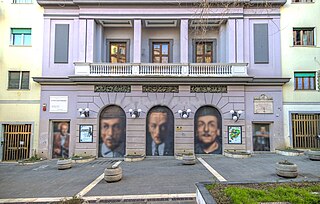
Teatro San Ferdinando is a theatre in Naples, Italy. It is named after King Ferdinand I of Naples. Located near Ponte Nuovo, it is to the southeast of the Teatro Totò in the western part of the neighborhood of Arenaccia. Built in the late eighteenth century, the seats are arranged in four box tiers, and the pit. It is most associated with Eduardo De Filippo and the productions of the 1950s under his direction. Closed in the 1980s and reopened in 2007, the San Fernando is managed by the Teatro Stabile of Naples.

The Teatro delle Dame, also known as the Teatro Alibert, was a theatre in Rome built in 1718 and located on what is now the corner of Via D'Alibert and Via Margutta. In the course of its history it underwent a series of reconstructions and renovations until it was definitively destroyed by a fire in 1863. In their 18th-century heyday, the Teatro delle Dame and its rival, the Teatro Capranica, were the leading opera houses in Rome and saw many world premieres performed by some of the most prominent singers of the time.

The Teatro Carcano is a theatre in Milan, Italy, located at 63 Corso di Porta Romana. Although now exclusively devoted to plays and dance, it served as an opera house for much of the 19th century and saw the premieres of several important operas. Completed in 1803, the theatre was commissioned by the Milanese aristocrat and theatre-lover Giuseppe Carcano and originally designed by Luigi Canonica. Over the succeeding two centuries it has undergone several restructurings and renovations and for a time in the mid-20th century functioned as a cinema.




